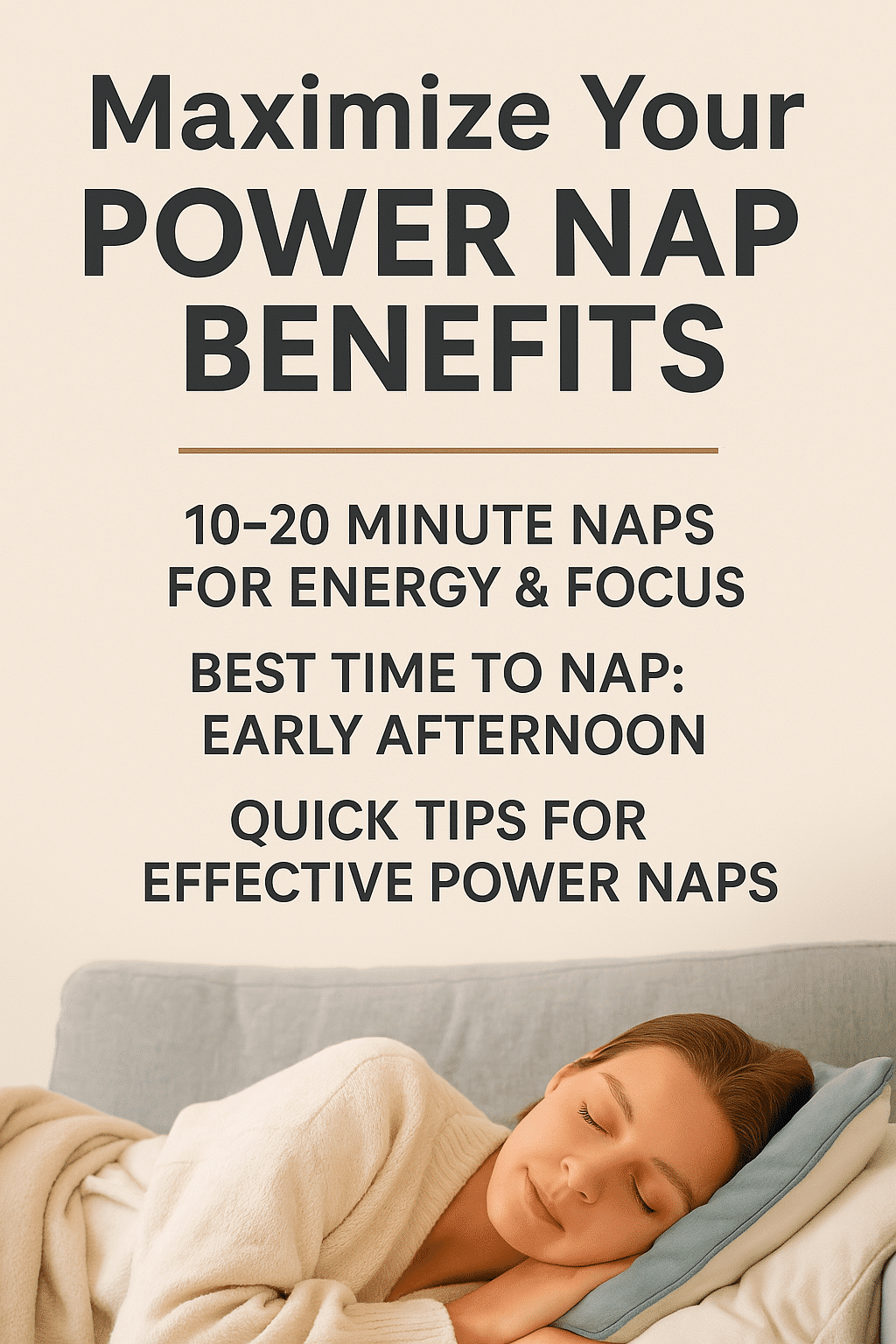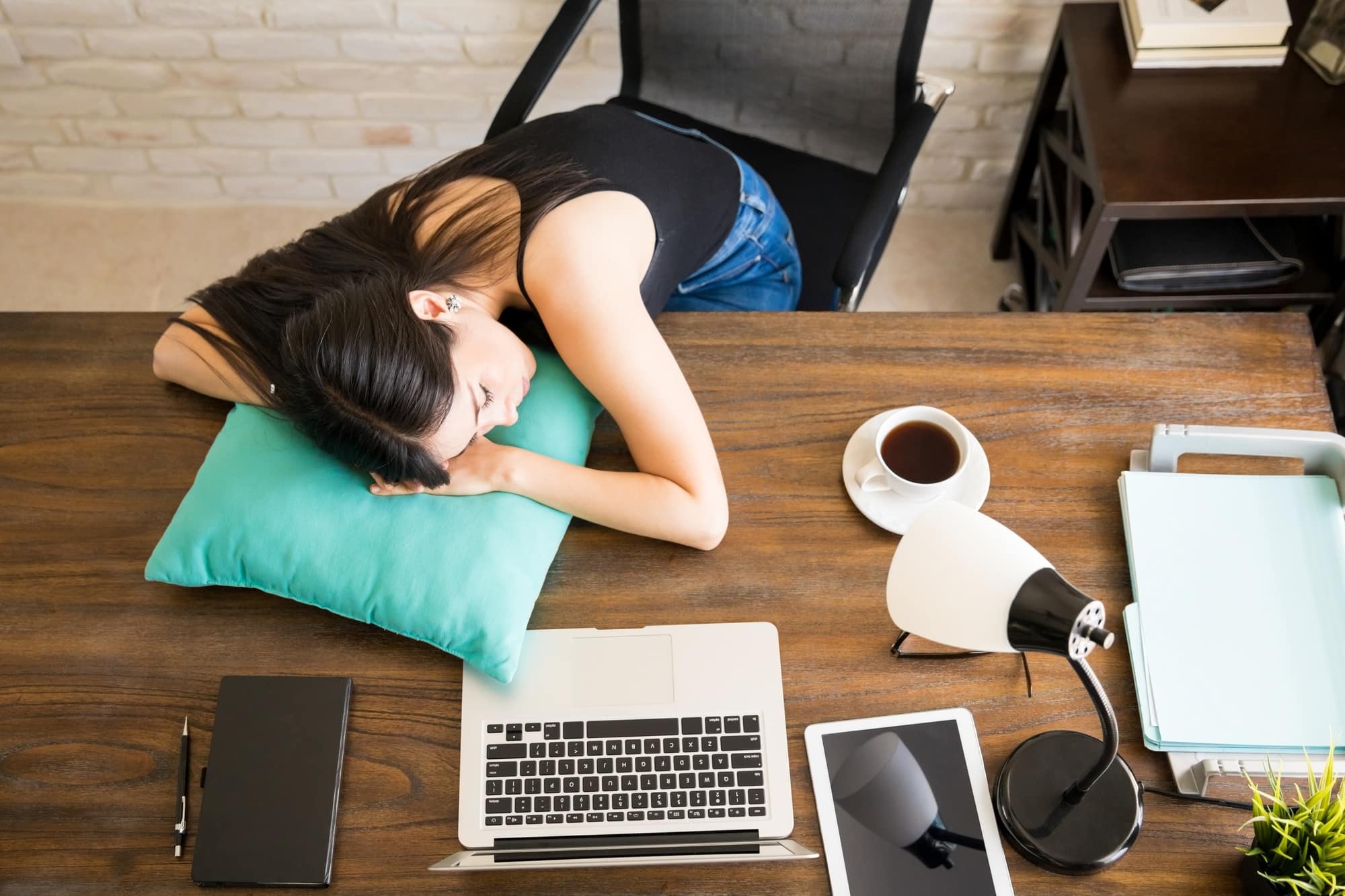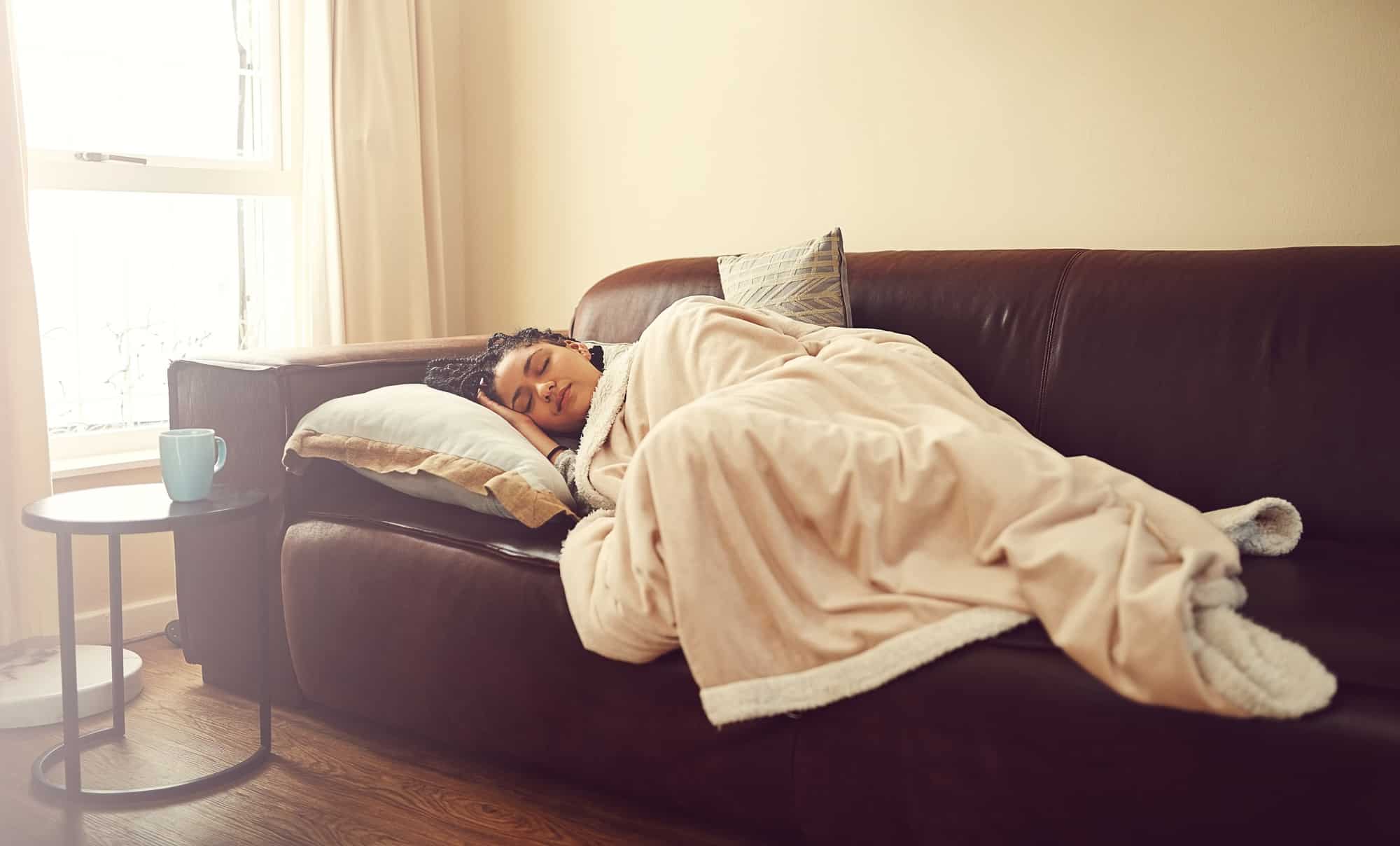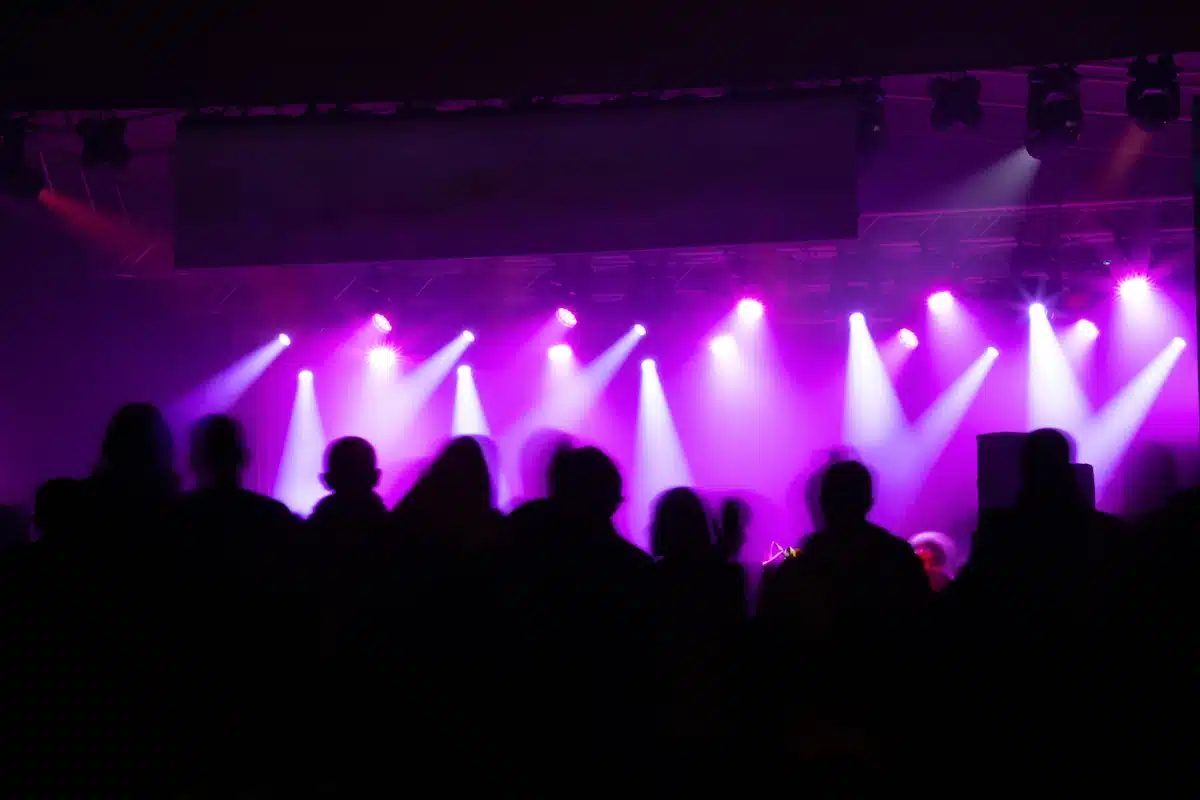Feeling that midday slump? A quick power nap might be the game-changer you didn’t know you needed. In this article, you’ll learn how just 10–20 minutes of rest can sharpen your focus, improve your mood, and recharge your energy—without messing up your nighttime sleep. Whether you’re working from home, managing a packed schedule, or simply looking for a better way to beat fatigue, this guide breaks down everything from ideal nap timing to creating the perfect nap space. Ready to make naps part of your wellness routine?
For more wellness tips, check out our articles on Healthy No-Bake Carrot Cake Bites and The Ultimate Guide to Healthy Snacks for Busy Days.
Key Takeaways
Harness the power of a 10-20 minute nap to boost alertness, cognitive function, and mood without grogginess.
Timing is key: aim to nap in the early afternoon to align with natural energy dips for maximum effectiveness.
To enhance your rejuvenation experience, create an optimal nap environment with cool temperatures, quiet surroundings, and relaxation techniques.

In this Article About the Benefits of Your Power Nap
Understanding the Power Nap

A power nap is a short period of sleep during the day, typically lasting 10 to 20 minutes. These brief daytime naps can significantly enhance alertness, improve cognitive functions, and reduce fatigue. Imagine hitting the reset button on your brain—just a few minutes of shut-eye can make a world of difference.
The benefits of napping extend beyond just feeling more awake. Power naps can improve mood, lower high blood pressure, and even boost memory and logical reasoning skills. However, the experience can vary; while some wake up feeling refreshed and energized, others might feel even more tired.
One of the key advantages of a power nap is its brevity. This short duration prevents you from entering deeper sleep stages, which means you wake up without the grogginess often associated with longer naps. So, whether you’re looking to enhance your focus or just need a quick pick-me-up, a power nap might be exactly what you need.
Health Benefits of Power Naps

Power naps come with a plethora of health benefits. For starters, they can lead to improvements in memory and creativity, making you more effective at problem-solving and innovation. Longer naps (60-90 minutes) that include REM sleep can enhance memory retention, creativity, and overall cognitive function. Short naps of 10-20 minutes can significantly improve focus and memory, allowing you to tackle your day with renewed energy.
Engaging in daytime napping can also lower stress levels and improve overall health. Imagine reducing your reaction times and enhancing cognitive performance, all while decreasing fatigue throughout the day. This practice particularly benefits shift workers, helping them maintain performance and recovery.
Additionally, napping can prevent the accumulation of sleep debt, improving your overall daytime functioning. Regular short naps are generally more beneficial for health than infrequent long naps. So, the next time you feel that midday slump, remember that a quick nap could be your ticket to better health and increased alertness.
Ideal Nap Length
Length matters when it comes to napping; power naps should ideally be kept short to maximize benefits without causing grogginess. NASA’s studies have shown that a nap of about 26 minutes can significantly enhance alertness and performance, while a brief nap lasting between 10 to 20 minutes is effective for a quick rejuvenation.
Napping for more than 30 minutes can lead to slow-wave sleep, which makes it challenging to wake up and can cause grogginess. This grogginess occurs because longer naps allow you to enter deeper stages of sleep, making it harder to wake up feeling refreshed. Keeping your nap to around 20 minutes can increase performance and alertness without interfering with your nighttime sleep.
The ideal nap length depends on your specific needs and schedule, but for most people, a brief nap of 10-20 minutes is the sweet spot for achieving the desired nap length. This duration helps you wake up feeling refreshed and ready to take on the rest of your day, without the drawbacks of longer naps.
Best Time to Take a Power Nap

Timing is crucial when it comes to napping. Power naps are most effective when taken in the early afternoon, ideally between 2 PM and 4 PM. This period aligns with a natural decrease in energy, enhancing alertness and cognitive function without impacting your nightly rest.
Understanding your body’s natural circadian rhythms can help you identify the optimal nap time. Most people experience a post-lunch dip in energy levels, making the early afternoon an ideal time for an afternoon nap. A dip in energy and performance typically occurs in the early afternoon, making it the perfect window for napping.
However, it’s advisable to avoid afternoon naps close to bedtime to prevent interference with nighttime sleep. So, set a reminder for a quick nap in the early afternoon, and you’ll be amazed at how much it can boost your alertness and productivity.
Creating an Optimal Nap Environment

Creating the right environment is key to a successful power nap. The ideal temperature for napping is around 65 degrees Fahrenheit. Find a quiet, comfy spot like a couch or spare room where you can relax without interruptions.
Sounds like white noise, nature sounds, or calming music can enhance your napping experience. Consider using blackout blinds or a sleep mask to reduce light during your nap. A sleep mask can be particularly effective in blocking out light, making it easier to fall asleep.
An optimal napping environment should be cool, quiet, and dark to help you get the most out of your brief snooze.
Techniques to Fall Asleep Quickly
To make the most of your power nap, it’s essential to fall asleep quickly. Relaxation techniques can help calm the mind and body, making it easier to drift off. Progressive muscle relaxation can be particularly effective when you tense and then relax different muscle groups.
Hypnosis and guided meditation are other techniques that can significantly enhance your ability to fall asleep quickly. These methods help quiet the mind and prepare your body for rest, often complementing sleep medicine.
When your power nap ends, get up promptly as soon as the alarm sounds and consider stretching or walking around to ease into wakefulness. By employing these techniques, you can maximize the benefits of your power nap and wake up feeling refreshed and ready to tackle the rest of your day.
Power Naps vs. Longer Naps
Choosing between power naps and longer naps depends on your needs and circumstances. A 90-minute nap allows the body to complete a full sleep cycle, enhancing overall rejuvenation without causing sleep inertia. However, longer naps of an hour or more may increase the risk of cardiovascular issues according to some studies.
A longer nap of 2 hours can enhance memory consolidation and creative thinking, but it may also lead to grogginess upon waking. The ideal duration for a nap should avoid deep sleep stages to prevent grogginess upon waking.
Ultimately, the choice between power naps and longer naps should depend on individual circumstances, such as the need for immediate alertness versus deeper rejuvenation. For most people, a brief power nap is the best choice for a quick boost of energy and focus.
How Power Naps Affect Nighttime Sleep
When taken correctly, power naps do not harm nighttime sleep quality and can provide equal or greater total sleep over 24 hours compared to those who do not nap. Sleep-deprived individuals may experience enhanced benefits from napping, but could also suffer from more severe symptoms of sleep inertia if they nap for too long. However, napping too late in the day can reduce sleep drive, leading to difficulties in falling and staying asleep at night.
Experts suggest avoiding naps after 3 p.m. to minimize interference with nighttime sleep schedules. Napping can be advantageous if it helps maintain alertness, but excessive daytime sleepiness may indicate health concerns.
For optimal benefits, individuals are advised to keep naps to 30 minutes or less to avoid grogginess and complications with nighttime sleep. Frequent long naps are associated with increased health risks, including cardiovascular issues.
How Napping Impacts the Circadian Rhythm
Napping can positively and negatively affect your circadian rhythm, depending on when and how long you nap. A well-timed nap can help regulate your body’s internal clock and improve the quality of your nighttime sleep. However, napping too close to bedtime or for too long can disrupt your circadian rhythm, making it harder to fall asleep at night.
Research suggests that napping during the day can help regulate your natural sleep-wake cycle by reducing sleep pressure, which is the build-up of the need for sleep. This can make it easier to fall asleep at night. Additionally, napping can help regulate body temperature, an important factor in maintaining a healthy circadian rhythm. Improved melatonin levels, the hormone responsible for regulating sleep-wake cycles, can also be a benefit of well-timed naps.
However, napping too close to bedtime or for too long can have negative effects. It can disrupt your sleep-wake cycles, reduce melatonin levels, and increase sleep inertia, the grogginess and disorientation you feel upon waking. To avoid these issues, aim for a short nap of 20-30 minutes during the early afternoon. This timing and duration can help you reap the benefits of napping without disrupting your circadian rhythm.
How to Use Napping to Improve Sleep Deprivation
Napping can be a powerful tool for combating sleep deprivation, but it’s essential to use it correctly. Here are some tips to help you use napping to improve sleep deprivation effectively:
Keep Naps Short: Short naps of 20-30 minutes are ideal for improving sleep deprivation. Longer naps can lead to sleep inertia, making it harder to fall asleep at night.
Time Naps Correctly: The best time to nap is during the early afternoon. Avoid napping too close to bedtime or in the morning, as this can interfere with your nighttime sleep.
Use Napping to Supplement Sleep: While napping can help fill in the gaps, it’s crucial to prioritize nighttime sleep. Aim for 7-9 hours of sleep each night and use napping as a supplement.
Avoid Relying Solely on Napping: While napping can be beneficial, addressing the underlying causes of sleep deprivation is essential. Establish a consistent sleep schedule, create a sleep-conducive environment, and avoid stimulating activities before bedtime.
Using napping correctly can improve sleep deprivation and enjoy better overall health and well-being. Remember, the goal is to enhance your nighttime sleep, not replace it.
Incorporating Power Naps into Your Daily Routine

Incorporating power naps into your daily routine can be a game-changer. If you work night shifts, scheduling a power nap before or during your shift can enhance performance and focus. Create a comfortable napping environment at home with blackout curtains or a white noise machine.
In an office environment, accessories such as earplugs or an eye mask can enhance your napping conditions. Setting an alarm for 20 to 30 minutes helps avoid grogginess upon waking after a power nap.
With these tips, you can make power naps a seamless part of your daily routine.
How to Start Napping for Better Health
Starting a napping routine can be a game-changer for your health, but it requires some planning and consistency. Here’s how to get started:
Set a Goal: Determine why you want to start napping. Whether it’s to boost your energy, improve focus, or reduce stress, having a clear goal will help you stay committed.
Choose a Nap Schedule: Decide on a nap schedule that works for you. Midday is often best in the early afternoon, around 2 PM to 4 PM.
Create a Sleep-Conducive Environment: Ensure you have a quiet, dark, and cool place to nap. Use blackout curtains, a sleep mask, or a white noise machine to create the perfect napping environment.
Start Small: Begin with short naps of 10-15 minutes and gradually increase the duration as needed. This will help your body adjust to the new routine.
Be Consistent: Stick to your nap schedule and make napping a routine. Consistency is key to reaping the benefits of napping.
Monitor Progress: Track how you feel after napping. Adjust your nap schedule as needed to ensure you’re getting the most out of your naps.
By following these simple steps, you can start napping and enjoy the many benefits of napping for better health. Whether you’re looking to boost your energy, improve your mood, or enhance your cognitive function, a well-planned napping routine can make a significant difference.
When to Avoid Napping
While napping offers numerous benefits, there are times when it’s best to avoid it. Napping after 5 PM can disrupt your ability to have a restful night’s sleep. Late afternoon naps can interfere with your nighttime sleep schedule, making it harder to fall asleep and stay asleep.
Individuals with existing sleep difficulties may find that napping exacerbates their nighttime sleep problems. While napping can offer relaxation, it is not a substitute for adequate nighttime sleep. It’s essential to find a balance that works for you.

The Role of Caffeine Naps
A caffeine nap, or coffee nap, combines drinking coffee with a brief nap to enhance alertness. The idea is to consume caffeine right before a short nap, allowing the stimulant to kick in just as you wake up. This can significantly boost your alertness and energy levels.
The ideal duration for a caffeine nap is around 20 minutes, allowing caffeine to activate as the nap concludes. This combination can be particularly effective for those needing a quick boost in alertness and focus.
Monitoring Your Napping Habits
To optimize your napping habits, consider keeping a nap diary. Sleep medicine reviews provide insights based on systematic reviews and research studies, focusing on evidence-based findings in the field of sleep medicine. Recording details such as nap duration, time of day, and sleepiness levels can help track the effectiveness of your naps. Updating your diary daily ensures accurate tracking and prevents memory gaps.
Maintaining a nap diary for at least a week can provide meaningful insights into your napping habits and help identify patterns that contribute to excessive daytime sleepiness. Reviewing this information can assist in making necessary adjustments to improve your overall sleep quality.
Summary
Power naps are a powerful tool for enhancing alertness, cognitive function, and overall health. You can maximize the benefits of your quick snooze by understanding the ideal nap length, best nap times, and how to create an optimal nap environment.
Incorporating power naps into your daily routine can improve performance, reduce stress, and improve mood. So, don’t hesitate to embrace the power of napping and make it a regular part of your day. Sweet dreams!
Power Nap FAQs
What is the ideal length for a power nap?
Aim for a 10—to 20-minute power nap to feel refreshed and alert; it’s the perfect way to recharge without feeling groggy when you wake up!
When is the best time to take a power nap?
The best time to take a power nap is in the early afternoon, ideally between 2 PM and 4 PM, when your body naturally craves a rest. Embrace this time to recharge and boost your energy!
Can power naps affect nighttime sleep?
Yes, power naps can positively impact your daytime alertness without harming nighttime sleep. However, avoid napping too late in the day to ensure you still have the drive to fall asleep at night. Keep your naps early and short for the best results!
What is a caffeine nap?
A caffeine nap is a powerful technique in which you drink coffee and then take a short nap. This combo can supercharge your alertness when you wake up. Give it a try, and feel the boost in your energy and focus!
How can I create an optimal nap environment?
To create an optimal nap environment, ensure the space is calm, dark, and quiet. Invest in blackout curtains or a sleep mask and consider using white noise to refresh your power naps!









